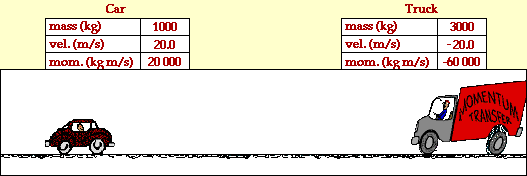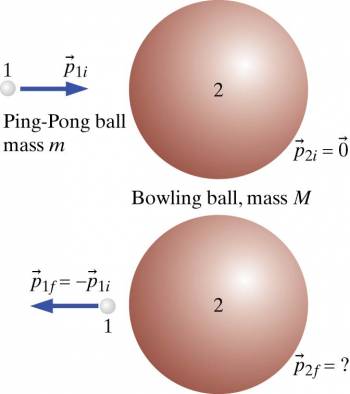Head-on Collision of Unequal Masses
claimed by gdweck3
Main Idea
A collision is any incident in which there is little interaction before and after a short time interval, during which there is a large interaction. The two main types of collisions are Elastic Collisions and Inelastic Collisions, but these are very broad as there are many much more specific types of collisions under these umbrella terms. One specific type of collisions is head-on collisions of unequal masses. This is exactly what it sounds like - two objects of different masses collide with each other head-on, causing changes in kinetic energy and momentum. To make this easier to visualize, imagine a ping-pong ball colliding with a bowling ball. You would observe the ping-pong ball bounce straight back with very little change in speed, and much less obviously, you will see the bowling ball's speed will also be altered.
It is generally true that when a low-mass projectile collides elastically with a stationary large mass, the low-mass projectile will bounce off with little change in speed or kinetic energy, but a large change in momentum. The large mass, on the other hand, will gain lots of momentum with very little change in speed or kinetic energy.
 Elastic head-on collision between a car and truck[1]
Elastic head-on collision between a car and truck[1]
The Equations Behind It
Most commonly, head-on collision of unequal masses are studied as elastic collisions, in which case, kinetic energy is conserved. What this means is that the total final kinetic energy of the system is equal to the total initial kinetic energy of the system. In equations, it looks like this: [math]\displaystyle{ {1 \over 2}m_1v_1i^2 + {1 \over 2}m_2v_2i^2 = {1 \over 2}m_1v_1f^2+ {1 \over 2}m_2v_2f^2 }[/math].
If the equation is inelastic, the idea of conservation of momentum can be used because momentum is always conserved in collisions. The equation for the conservation of momentum is: [math]\displaystyle{ m_1v_{1,i}^2 + m_2v_{2,i}^2 = m_1v_{1,f}^2 + m_2v_{2,f}^2 }[/math]
As referenced to before, the ping-pong and bowling ball example clearly demonstrates what occurs in a head on collision of unequal masses. Say the system consisting of the ping-pong and bowling balls is in outer space. The ping-pong ball of mass m is traveling in the +x direction with initial momentum p_{1,i}, and hits a stationary bowling ball of mass M head on.
Since the bowling ball is at rest when the ping pong ball hits it, the final momentum of the bowling ball is twice the initial momentum of the ping pong ball. This can be seen by using the conservation of momentum principle:
[math]\displaystyle{ p_{1,f} + p_{2,f} = p_{1,i} + p_{2,i} }[/math]
assume the speed of the ping-pong ball doesn't change significantly, so [math]\displaystyle{ p_1f=-p_1i\lt math\gt (about) so then: \lt math\gt -p_{1,i} + p_{2,f} = p_{1,i} }[/math] and [math]\displaystyle{ p_{2,f} = 2p_{1,i} }[/math]
Knowing the speed of the ping pong ball remains about the same, the new equation is [math]\displaystyle{ -p_{1,i} + p_{2,f} = p_{1,i} }[/math] which gives [math]\displaystyle{ p_{2,f} = 2p_{1,i} }[/math] showing that the final momentum of the bowling ball is twice the initial momentum of the ping pong ball. Although this is a very specific circumstance, different variables of the equation can be solved by using the conservation of momentum principle.
Example
In an orbiting spacecraft a ping-pong ball of mass m (object 1) traveling in the +x direction with initial momentum [math]\displaystyle{ p_1i }[/math] hits a stationary bowling ball of mass M (object 2) head on. What are the a) momentum, b) speed, and c) kinetic energy of each object after the collision? Assume little change in the speed of the ping-pong ball, and assume that the collision is elastic.
1. [math]\displaystyle{ -p_{1,i} + p_{2,f} = p_{1,i} }[/math] [math]\displaystyle{ p_{2,f} = 2p_{1,i} }[/math]
Because momentum is conserved, it can be seen that the final momentum of the bowling ball is twice the initial momentum of the ping-pong ball.
2. [math]\displaystyle{ V_{2,f} = {P_{2,f} \over M} = {2P_{1,i} \over M} = {2mv_{1,i} \over M} = 2{m \over M}V_{1,i} }[/math]
This will be a very small speed, considering m<<M.
3. [math]\displaystyle{ K_{2,f} = {(2p_{1,i})^2 \over 2M} }[/math] and [math]\displaystyle{ K_{1,f} = {(p_{1,i})^2 \over 2m} }[/math]
Because the mass of the bowling ball (M) is much larger than the mass of the ping-pong ball, the kinetic energy of the bowling ball is much smaller than the kinetic energy of the ping-pong ball.
Links to Videos
https://www.youtube.com/watch?v=dUJMxUk00f4 https://www.youtube.com/watch?v=GNODL1bwDCw https://www.youtube.com/watch?v=Wb-62w-xt7g
See also
Further reading
Matter and Interactions By Ruth W. Chabay, Bruce A. Sherwood - Chapter 10
External links
- http://hyperphysics.phy-astr.gsu.edu/hbase/colsta.html
- http://www.dummies.com/how-to/content/how-to-calculate-velocities-of-two-objects-with-di.html
